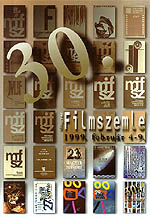 |
Vol 0, No 25
16 March 1999 |
|
|
Crushing Defeats (Part II): Hungary vs Hollywood Andrew J Horton To read Crushing Defeats, Part I Many of the films shown at the 30th Hungarian Film Week tried to imitate, build on or even challenge the success of Hollywood films in Hungary. The results have been surprisingly humorous. Hungarian cinema has not traditionally been known for either action films, thrillers or light romantic comedies. The foundations which cinematography in Hungary were built on - early Soviet film-making and documentaries - seem in this day and age to be a recipe for financial disaster. Whilst Hungarian cinema attracted international attention in the 60s and 70s with chilling exposes of the brutalities of totalitarianism, these days, thoughtful, glum films are perceived as being unsatisfactory by the modern Hungarian cinemagoer. This is an interesting state of affairs, given that there is a lot for Hungarians to reflect on at the moment. But if audiences want to forget reality when they visit the cinema, the directors must of course obey their every whim. This year's Hungarian Film Week presented three films which displayed the distinct influence of Hollywood: Csaba Horvath's debut Europa Expressz, Tamas Sas's Kalozok (Pirates, 1997) and Robert Koltai's Ambar tanar ur (Professor Albeit). They all aim to introduce the gloss and infectious optimism of Hollywood films into a Hungarian setting, and above all they attempt to mimic the profits of American blockbusters. An unintentional comic masterpiece Csaba Horvath's Europa Expressz is the most self-conscious in its attempts to challenge Hollywood. The production notes bravely promise that the film will introduce a new genre to Hungarian cinema. Horvath tries to pump in all the edge-of-the-seat ingredients which make a thriller work: guns, smuggling, mindless violence, organised crime, corruption, romance and above all a sense of speed. As the very title of the film suggests, Horvath wants his film to be European in outlook but with the magic Hollywood touch. This is a demanding aim for a new director and it is hardly surprising that he fails. Europa Expressz may be an international express train, but the film rattles along with all the excitement of an early-morning tram on its way to the steelworks. Along the way there are plenty of opportunities to marvel at the stunning haircuts, the stilted dialogue and the primitive special effects (yes, you can actually see the pouches of "blood" attached to their skin when they get shot.) It is a long time since America made films of this admirably low quality and the producers of Europa Expressz may have been unwittingly accurate when they said that this film will create a new genre. In the following decades I have no doubt that Hungarian thirty-somethings will get together over a few bottles of palinka and revel in the tackiness of Europa Expressz, in much the same way that discerning Anglo-American fans of kitsch cherish episodes of Magnum PI. Kalozok is infinitely less camp but no less cliched. Tamas Sas is not a director to be messed with. His debut film last year, Presszo (Espresso, 1997) won the Grand Jury award. Impressed by how effectively he made use of limited resources, a single camera angle throughout the entire film, his producers have entrusted him with far more money. The result is smooth and slick and sexy. The film tells the tale of two pirate radio DJs whose close friendship is torn apart when one of them is offered a job at a professional radio station. Worse still, they both fall in love with the same woman. The resulting plot sees them trying to resolve their feelings for the object of their desire and in doing so get back to the important business of having a man-to-man friendship, which nothing can take priority over [see Kinoeye in Vol 0, issues 9, 11 and 17 for further examples of this popular, misogynistic story line]. With a safe soundtrack of middle-of-the-road jazz/rock, a languid summer atmosphere and warm close-to-the-mike studio sound quality, Kalozok is likely to be more popular in the short term than Europa Expressz. Its comforting message to Hungarian audiences is that you, too, really can live in Hungary in the 90s and be happy. This may sound like pap, and indeed it is, but the film does have an unexpected advantage to the international viewer. Arriving on my first day at the festival, the well-meaning but as yet unprepared festival staff mistakenly ushered me into a showing of Kalozok without English translations. Despite having only embryonic Hungarian language skills, I was able to understand everything which was happening in the film, so naive and formulaic is its story line. Don't be put off if you would like to see it but can't find a version with subtitles. Get 'em while they're young?
In America, these sorts of scenarios are avoided if possible, with directors unwilling to be seen as party to pedophilia. Central Europeans are far less inhibited in such matters, and the passionate love an ageing would-be magician turned school teacher has for one of his pupils is deemed appropriate material for a light family comedy. Whether this is a worrying reflection of the acceptability of sexual exploitation in Hungary or a lamentable comment on the ageism and sexual hypocrisy of Hollywood, I would not care to say. The two are certainly different views, however. Those shocked by the idea of romance between a teacher and his charge need not worry, though, for three reasons. Firstly, Timea is in the fourth grade and therefore not a minor. Secondly, the relationship is not consummated and Romeo ultimately sublimates his lust for Timea by marrying her mother. Thirdly, Timea, despite being in the fourth grade, is in fact quite obviously in her mid-twenties, as indeed are most of her school-mates. It should be noted that Kata Doba, who plays Timea, was more plausibly cast as a mature and confident gun-wielding undercover cop in Europa Expressz. Measuring up against America Ignoring cultural differences in sexual politics, Ambar tanar ur is the most convincingly American of the three films and one could quite easily imagine Robin Williams, had he been desperately strapped for cash, taking the role of Romeo in an American version of the film.
Even so, it has to be said that the film is assured and amusing and taking it at the level at which it was intended - a vacuous piece of entertainment designed to pack in audiences - the film is quite competent. The local success of the film has, in fact, been phenomenal, with the film being the top Hungarian film of 1998, despite only being realised on 12 December with a few weeks of the year left. None of these three films will turn the tide of American imports, and Hungarian audiences will never cease to demand Hollywood products. Hungary is new to the business of crowd-pleasing and directors still have a lot to learn. Of course, it goes without saying that none of these films will ever truly be able to compete with Hollywood. They are not American enough to attract attention in America and not European enough to attract attention in Europe and, in the final analysis, they demean Hungarian cinema. Andrew J Horton, 16 March 1999
|
| |||||||||||||||||||
![]()
Copyright (c) 1999 - Central Europe Review and Internet servis, a.s.
All Rights
Reserved


